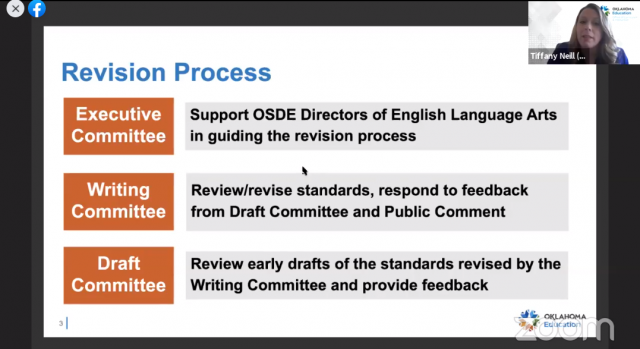
During a special meeting this morning, the Oklahoma State Board of Education unanimously approved proposed academic standards revisions for English Language Arts curriculum.
These revisions build on 2016 standards and include extending objectives such as phonetic awareness to second through third grades to help students be more proficient readers; introducing various writing topics, such as pre-writing and revising, at earlier grade levels to enforce stronger reading and writing skills; and providing more clarity for teachers regarding expectations for students in their grade level.
Deputy Superintendent of Curriculum and Instruction Tiffany Neill presented the board with the standard revisions, which are part of a six-year cycle of review.
The revision process is completed by an executive committee, a writing committee and a draft committee. The writing committee is made up of 25 members representing 22 school districts and two higher education institutions from around the state. The draft committee has 35 members representing 26 school districts and one higher education institution.
The process began with all three committees developing attributes of quality standards for English Language Arts.
“The first attribute is that the standards should represent a rigorous learning goal to support college and career readiness, provide a clear, concise and comprehensible set of expectations to English Language Arts educators and represent a clear component of learning across the grade bands,” Neill said. “What this means is the standards build intentionally from grade level to grade level and serve as building blocks for students in their learning and school development in literacy.”
Neill said the final two attributes of quality standards for ELA are that they should lead to instruction that is interesting and relevant to diverse student populations and should help develop students who are literacy proficient and become life-long readers and writers.
New standards emphasize ‘science of reading’
The shifts in ELA standards include stronger alignment to the science of reading, increased clarity for ELA teachers, strengthened progressions for pre-K through 12th grades and stronger alignment to measures of college and career readiness.
“We know that when you teach based on the science of reading and cognitive development, children can overcome learning disabilities, they can overcome dyslexia, they can overcome struggles with reading,” State Superintendent of Public Instruction Joy Hofmeister said. “We are going about a time of providing broad professional development that is based in all of the components of the science of reading. When we do this, we will see a direct change that corresponds with that training in our students’ performance in early reading.”
The revised ELA standards will head to the legislature for approval.
“It is our intent to have curriculum frameworks developed for every subject area in the coming two years,” Neill said. “We have fine arts that will be published probably within the month, we’ll have an update to the science curriculum framework and we’ll begin areas like computer science, world languages and physical education and health as well.”
OCAS waivers denied
During the meeting, board members also unanimously voted to deny waiver requests submitted by a number of public schools that failed to meet Oklahoma Cost Accounting System deadlines, with the exception of Chandler Public Schools.
All public schools in the state are required to report all income and expenditures for the previous fiscal year in the OCAS system on scheduled deadlines. Districts must report this information by Sept. 1 with Sept. 30 as the deadline for districts to certify that all information provided is true and correct.
Failure to report information in the OCAS system by the deadline results in a reduction of state aid for the district on a scale basis. Districts will have one percent of state aid deducted for the first month of not meeting the deadline, two percent for the second month and so on, up to five percent.
There were a total of 11 school districts that failed to meet the Sept. 1 deadline and 45 districts that failed to meet the Sept. 30 deadline. Three school districts, Healdton, Rock Creek and Turpin Public Schools, failed to meet both deadlines.
Tom Pickens with Perry Public Schools was in attendance at Thursday’s meeting to provide explanation of the district’s failure to meet reporting deadlines.
“We had a ransomware virus issue and our budget maker and auditor who we have to run everything through to make corrections became ill with COVID,” Pickens said. “What we’re asking for in approval of this waiver is forgiveness of the state aid penalty because there were challenges that were out of our control. We were late and we apologize for that.”
During the meeting, board member Jennifer Monies asked State Department of Education Executive Director of Financial Accounting Katherine Black if the number of schools missing the deadline and applying for waivers this year was the same as a non-COVID affected year. Black said the number districts failing to meet the Sept. 1 deadline was in the normal range of past years.
The board’s legal counsel, Brad Clark, told the board that there is also a ‘good cause’ window at the end of the Sept. 30 deadline that allows schools to submit a request between Oct. 1 and Dec. 1 for an extension to make changes to data. All 35 districts that submitted a ‘good cause’ document this year were granted the correction time.
“This is what the statute requires. This is what’s obligated by law to do. Ninety percent plus school districts, even in the middle of COVID, were able to meet this deadline,” Monies said. “While I understand that there are challenges, I also, especially given that it’s normally about this amount COVID or not, think at some point we need to draw a line in the sand….”
Fellow board members echoed Monies’ sentiments, including Hofmeister.
“I believe deadlines need to mean something so that we can have accurate statistical data that is then aggregated for our state and moved forward with accuracy,” Hofmeister said.





















